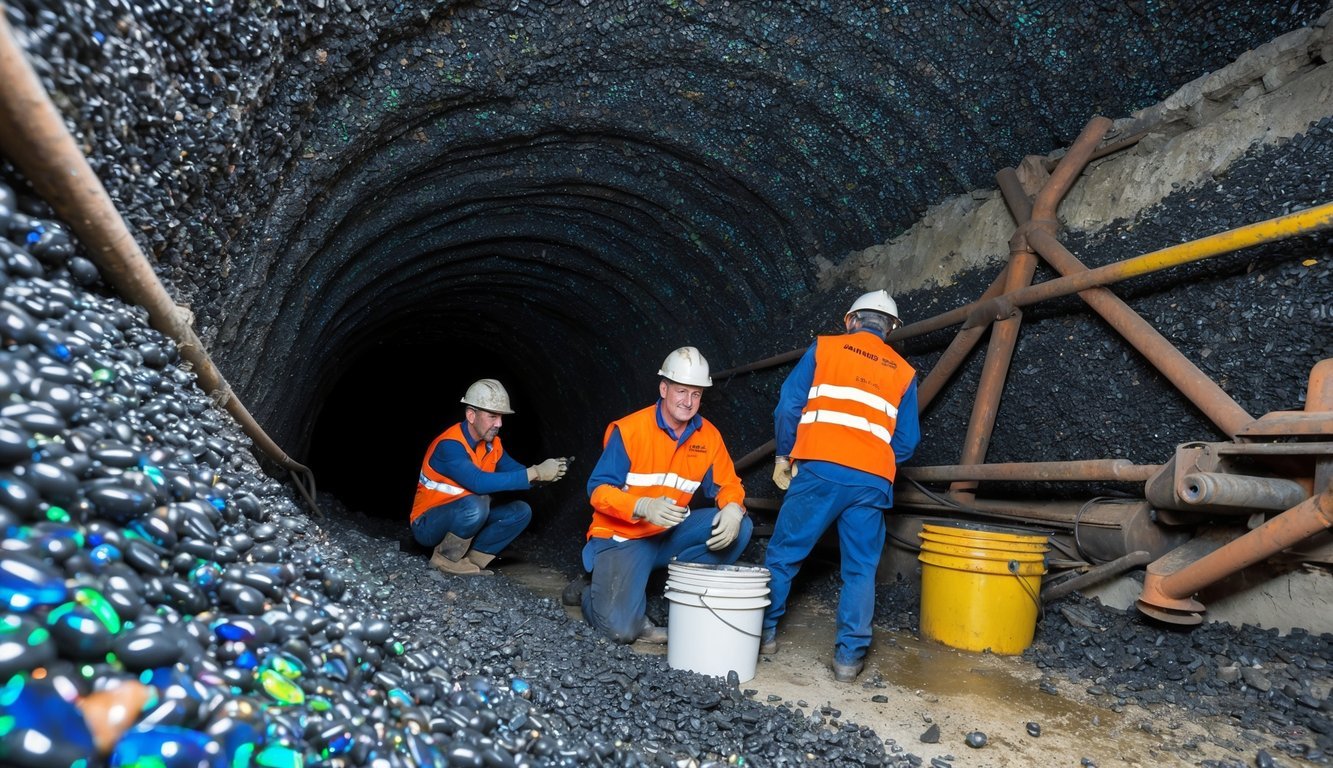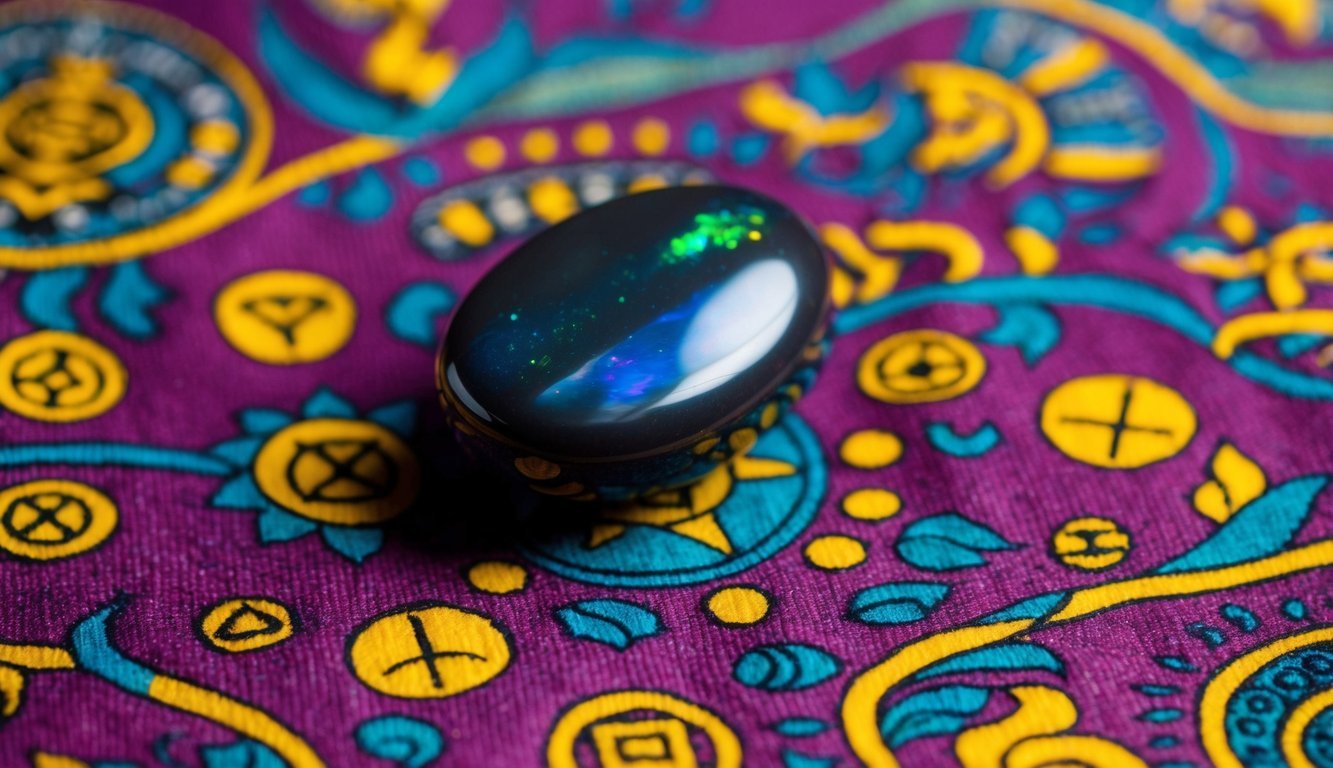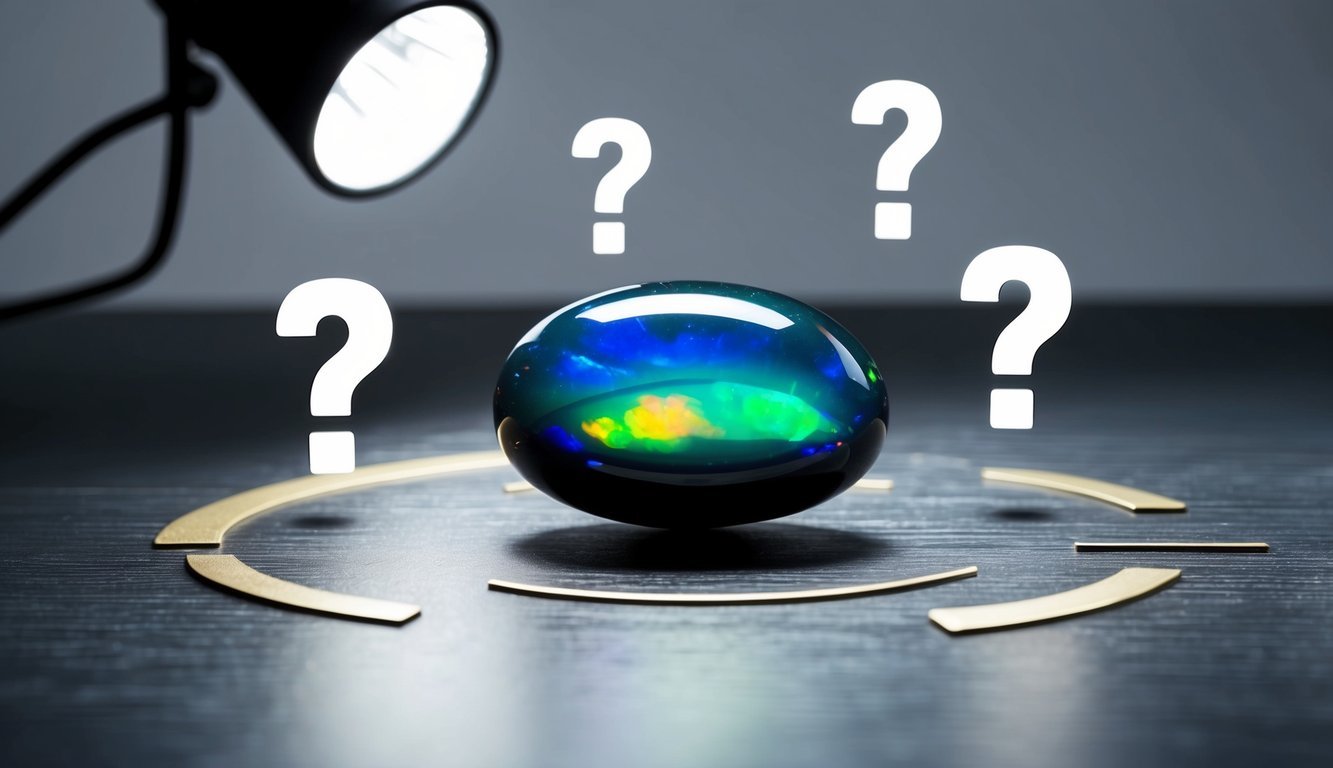PsychNewsDaily Publishers
100 Summit Drive
Burlington, MA, 01803
Telephone: (320) 349-2484
PsychNewsDaily Publishers
100 Summit Drive
Burlington, MA, 01803
Telephone: (320) 349-2484
Black opals are rare gemstones known for their dark body tone and vibrant play of color, primarily sourced from Lightning Ridge, Australia, enhancing their desirability and value.

Black opals captivate me with their mysterious darkness and exploding colors unlike any other gemstone on earth. They’re truly nature’s most mesmerizing canvas, displaying colors that seem almost magical against their dark background.
Black opal is considered by many experts to be the most desirable of all opal varieties. What makes it so special? Well, it’s that dark body tone that creates such a striking contrast with the flashes of color.
Unlike regular opals with their milky or white backgrounds, black opals have this amazing dark backdrop that makes colors pop like fireworks against a night sky. I’ve always thought they look like little universes captured in stone!
The darkness isn’t actually black dye or treatment – it’s natural. Though some lower quality stones might be treated with smoke to enhance their appearance, the finest black opals have natural dark backgrounds ranging from dark gray to nearly pure black.
Their rarity adds to their allure too. They’re much harder to find than common opal, which makes them especially precious to collectors like me.
When I first saw a black opal, I couldn’t believe my eyes – it was like someone captured a rainbow and trapped it in obsidian. That’s what gemologists call “play of color,” and black opals show it better than any other stone.
The colors dance and shift as you rotate the stone, showing virtually every hue imaginable. Red, blue, green, purple, yellow – sometimes all in one stone! I’ve noticed that the most valuable pieces display bright reds and blues.
This magical effect happens because of the silica spheres inside the opal. These tiny spheres stack up in patterns that split light into its component colors. Honestly, it makes me think of how a CD splits light, but way more beautiful.
The patterns have cool names too – harlequin, pinfire, and flash. My favorite is the rare “broad flash” pattern that shows large areas of solid, vibrant color.
Australia is the undisputed king of black opal production. I’d say about 95% of the world’s finest black opals come from a small town called Lightning Ridge in New South Wales.
The discovery of black opals at Lightning Ridge around 1908 changed the gemstone world forever. I find it amazing that this remote, rugged area produces something so extraordinarily beautiful.
The harsh Australian outback conditions are actually perfect for opal formation. These gems form in the cracks and cavities of sandstone that was once ancient seabeds. Over millions of years, silica-rich water seeped down and eventually hardened into opal.
Other locations produce black opal too, like Ethiopia and Indonesia, but they don’t quite match the quality of Australian stones. I wonder if it’s something special about the Australian geology that makes their opals so spectacular?
Mining them isn’t easy – it’s hot, dusty work requiring lots of patience. But when miners hit a seam of black opal, it’s like striking gold!

Black opal mining is a fascinating adventure that takes us deep into the earth’s crust where these precious gems have formed over millions of years. Australia leads the world in black opal production, with unique mining techniques developed specifically to find these rare treasures without damaging them.
Lightning Ridge in New South Wales, Australia is the world’s primary source of black opal. I’ve always been amazed by how this small town produces almost 95% of the world’s finest black opals! The unique geological conditions there – ancient inland seas and silica-rich sedimentary rocks – created the perfect environment for these gems.
Other Australian sites like Tintenbar in NSW have historically produced black opals too, though not as consistently as Lightning Ridge.
Outside Australia, Ethiopia has emerged as a promising new source in recent decades. I remember when the first Ethiopian black opals hit the market – they weren’t exactly the same as Australian stones, but still beautiful in their own way.
Black opal mining isn’t like other gem mining – it requires patience and specialized techniques. Traditional methods include shaft mining, where miners dig vertical shafts down to the opal-bearing layer, sometimes 80 feet deep! Honestly, it makes me think about those early miners who did this with just picks and shovels.
Open-cut mining is used in some areas, where large sections of earth are removed to expose the opal-bearing layers. I find this method fascinating because it’s more efficient but requires heavy machinery.
The most exciting part is what miners call “noodling” – sifting through discarded tailings to find opals that were missed. Some of the best stones have been found this way! The entire mining process is labor-intensive, which explains why these gems are so prized and valuable.

Black opals are among the rarest and most valuable gemstones in the world. The way we determine their worth depends on several key factors that experts and collectors look for when examining these precious stones.
When I look at a black opal, the first thing that catches my eye is always the play of color against that dark background. The most valuable black opals show vibrant, bold colors that seem to dance and shift as you move the stone. Reds and blues are particularly prized, especially when they appear in broad patterns across the stone.
The brightness rating is super important too. We grade this from 1 to 5, with 5 being the brightest. I’ve noticed that stones with a brightness of 4 or 5 can fetch prices that are just mindblowing!
The darkness of the body tone also matters a ton. True black opals have a dark body that makes the colors pop dramatically. Honestly, it makes me think of seeing fireworks against a night sky – that contrast is what creates the magic.
The pattern of the color play is something I can stare at for hours. Regular patterns are nice, but those rare harlequin patterns with their mosaic-like appearance? They’re worth way more than random patterns.
Size and thickness matter too. Larger stones with good color throughout are extremely rare, which is why the value increases exponentially with size. A 5-carat black opal with excellent qualities might be worth 10 times more than a 1-carat stone of similar quality!
I’ve learned that potch (the common form of opal without play of color) is often backing black opals and affects their value. The hardness is about 5.5-6.5 on the Mohs scale, which means we need to be careful with them.
Clarity and transparency are tricky with opals. Some cloudiness can reduce value, but slight transparency that allows light to interact with the color play can actually increase it. I wonder if that’s why I’m so drawn to stones that have that perfect balance of mystery and light?

Black opals transform from rough stones into stunning jewelry through careful work and skill. The journey requires expert hands and special techniques that respect the stone’s unique qualities.
Working with black opals is honestly something that gives me goosebumps – these precious gems require extra careful handling! Unlike other gemstones, black opals contain significant moisture that makes them tricky to cut. I’ve watched craftsmen spend hours just studying a single stone before making the first cut.
Most cutters prefer to shape black opals into a cabochon – that’s a smooth, rounded shape without facets. This style best shows off the play-of-color that makes these stones so special. I wonder if people realize that cutting an opal is way different from cutting diamonds or rubies?
The best jewelry designers build settings that protect the stone’s edges. They often use gold or silver to create bezels that wrap around the opal. Very few craftsmen specialize in Australian black opals because they’re so rare and valuable – one mistake can ruin thousands of dollars!
I’ve learned the hard way that black opals need special care! Since they contain water, they can crack if they dry out. I always store my pieces in a soft pouch with a tiny bit of moisture – not wet, just slightly humid.
Never use ultrasonic cleaners or harsh chemicals on your black opal jewelry. Trust me, it’s a disaster waiting to happen! Instead, I gently wipe mine with a soft, damp cloth. Hot water, dish soap, and extreme temperatures are big no-nos too.
When wearing your black opal pieces, put them on last after makeup and hairspray. I take mine off before swimming, gardening, or doing housework. They’re softer than most gems at about 5.5-6.5 on the Mohs hardness scale.
Watch out for synthetic black opals that look like the real thing! Genuine stones have natural variations and unique patterns that can’t be perfectly copied.

Black opals have fascinated people throughout history with their mysterious beauty and supposed powers. They’ve been both feared and treasured across different cultures, influencing beliefs and practices that continue to this day.
Black opals have a complicated history that’s kinda fascinating. In ancient times, many cultures believed these stones had magical properties – some good, some not so much. Romans thought opals were symbols of hope and purity, while later in medieval Europe, they got a bad rap as stones of misfortune. I’ve read that black opals in particular were sometimes associated with witchcraft and sorcery, which made people fear them.
In some indigenous Australian traditions, opals were deeply respected. They believed these stones were created when rainbows touched the earth. I find it interesting how these beliefs cut across cultural and economic lines, showing how important these gemstones were to so many people.
Today, black opals are often linked to protection and calm. As an October birthstone, they’re thought to ward off negative energy and fear. I’ve noticed how many people wear them for their supposed protective aura – honestly, it makes me think there might be something to these ancient beliefs.
In the metaphysical community, black opals are valued for their spiritual qualities and ability to enhance intuition. They’re said to help with:
Many crystal healers suggest that black opals have a unique energy that helps ground us while connecting to higher consciousness. I’ve tried holding one during meditation, and while I can’t explain it scientifically, there’s definitely something special about these stones!

Black opals spark tons of questions from gem lovers and collectors alike. These stunning stones come with their own mysteries and special qualities that make them highly sought after in the jewelry world.
Figuring out a black opal’s value is kinda like solving a puzzle with multiple pieces. Color is super important – the more vibrant and diverse the play-of-color, the more valuable the stone.
The background darkness matters too. The darkest stones with the brightest color flashes are what we call black opals and they’re considered the most desirable.
Size affects price as well, but I’ve seen smaller stones with amazing color patterns fetch higher prices than larger, duller ones. It’s not just about how big it is!
Throughout history, black opals have been wrapped in mystical beliefs. I’ve always loved how they’re thought to enhance intuition and protect the wearer from negative energies.
Many cultures believe these stones help people tap into their subconscious and boost creativity. The way they flash with color in the darkness makes them symbols of finding light in difficult times.
In Australia, where many of the finest specimens come from, some indigenous stories connect these gems to the creation of the earth and cosmic events. Pretty amazing when you think about it!
The pricing of black opals can be a bit confusing compared to other gems. Unlike diamonds which have standardized pricing, opals are way more subjective.
Some dealers price by carat (like most gemstones), but others use a per-gram basis. I’ve noticed this mostly depends on where you’re buying from. Australian dealers often use grams, while international markets might stick with carats.
The reason for this weird situation is that opals vary so much in density. Two stones of identical size might weigh differently, making the highly esteemed black opal tricky to standardize.
I’ve learned some tricks over the years to spot fake black opals. Real black opals have natural irregularities – the color patches move and shift as you rotate the stone in different lighting.
Synthetic or treated opals often have too-perfect patterns or color flashes that look suspiciously uniform. They might also have a “too good to be true” appearance.
Weight can be a clue too. Some fakes use plastic or glass that feels lighter than genuine opal. Water tests can help – real opals are slightly porous and might become more translucent when wet for a moment.
Absolutely! The location makes a huge difference. Lightning Ridge in Australia is famous for producing what most experts consider the finest black opals in the world.
I’ve seen Ethiopian black opals too, but they tend to have different characteristics – sometimes more hydrophane properties (they absorb water more easily) which affects how they should be set in jewelry.
I’ve watched the market for years. Black opals actually tend to appreciate better than many other gemstones. Their rarity is a huge factor. Truly fine specimens are incredibly scarce.
Unlike diamonds, which have controlled supplies, top-quality black opals are becoming harder to find. The famous mining areas produce fewer exceptional stones. This natural scarcity helps maintain their value.
Investment-wise, I’ve noticed that the most valuable pieces have documentation of their origin. Especially if they come from renowned mines like those in Lightning Ridge. The Australian black opal district has such a strong reputation that provenance adds significant value.